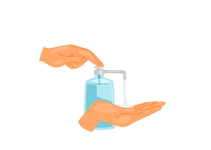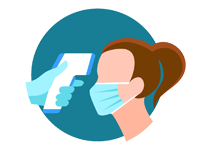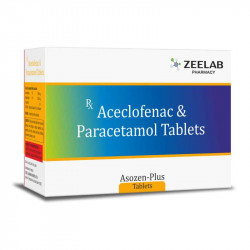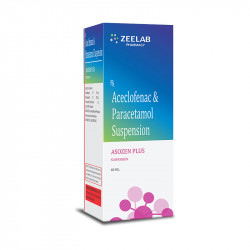Aceclofenac + Paracetamol
Aceclofenac + Paracetamol is a widely prescribed combination medicine used to relieve pain, inflammation, and fever in a variety of conditions. Aceclofenac belongs to the class of nonsteroidal anti-inflammatory drugs (NSAIDs) and works by blocking the chemical actions that cause pain and inflammation. Paracetamol (also called acetaminophen) is a commonly used medicine that helps reduce pain and lower fever by acting on the part of the brain that controls pain and body temperature.
This combination is frequently prescribed for musculoskeletal pain, osteoarthritis, rheumatoid arthritis, dental pain, headaches, post-surgical discomfort, and fever associated with various illnesses.
Available Medicine for Aceclofenac + Paracetamol
Uses of Aceclofenac + Paracetamol
-
Osteoarthritis: Aceclofenac + Paracetamol reduces joint pain, swelling, and stiffness in osteoarthritis patients, improving mobility, flexibility, and daily functioning. Its anti-inflammatory and analgesic effects help manage chronic degenerative joint disease while enhancing quality of life.
-
Rheumatoid Arthritis: This combination alleviates joint pain, tenderness, and swelling in rheumatoid arthritis, effectively controlling inflammation. It provides symptomatic relief alongside disease-modifying treatments, supporting better joint function and reducing discomfort during both acute flares and chronic disease progression.
-
Ankylosing Spondylitis: Aceclofenac + Paracetamol helps reduce spinal inflammation, stiffness, and lower back pain in ankylosing spondylitis patients. It improves spinal mobility, flexibility, and functional ability, enhancing comfort during daily activities and physical movement.
-
Dental Pain: The combination is effective for toothache, post-dental procedure pain, and oral surgery discomfort. It relieves pain and inflammation locally, supporting faster healing and improving patient comfort during routine or invasive dental treatments.
-
Postoperative Pain: Aceclofenac + Paracetamol is used to manage moderate post-surgical pain and inflammation. Its analgesic effect improves patient comfort, reduces reliance on stronger opioids, and aids faster recovery while maintaining mobility after surgical interventions.
-
Myalgia (Muscle Pain): It alleviates soreness, stiffness, and inflammation in muscles caused by overuse, strain, or minor injury. The combination helps restore mobility, reduces discomfort, and allows patients to resume daily or physical activities more comfortably.
-
Lumbago (Back Pain): Aceclofenac + Paracetamol reduces lower back pain, stiffness, and associated inflammation from mechanical or inflammatory causes. It enhances movement, eases discomfort during daily tasks, and supports improved spinal function and quality of life.
-
Neck Pain: Aceclofenac + Paracetamol effectively relieves acute or chronic neck pain caused by muscle strain, cervical spondylosis, or poor posture. It reduces inflammation, stiffness, and discomfort, improving neck mobility and daily functioning.
-
Gout Attacks: During acute gout flares, the combination relieves intense joint pain, redness, and swelling by reducing the chemical activity that causes inflammation. It helps improve joint function and patient comfort while adjunctive therapies manage uric acid levels.
-
Soft Tissue Injuries: Effective for pain, swelling, and inflammation from sprains, strains, or minor trauma to muscles, ligaments, or tendons. Aceclofenac + Paracetamol supports faster recovery, reduces discomfort, and helps patients return to normal physical activity.
-
Headache / Migraine-Associated Pain: The combination relieves moderate headache or migraine-related pain, including tension-type headaches. Its anti-inflammatory and analgesic properties reduce discomfort, improve daily functioning, and enhance overall patient well-being during acute pain episodes.
-
Alleviation of back pain and neck pain caused by strain: It relieves back and neck pain from strains by reducing inflammation, easing muscle stiffness, blocking pain signals, restoring mobility, and improving comfort, providing effective relief and supporting faster recovery from musculoskeletal discomfort.
Aceclofenac + Paracetamol – Available Forms & Strengths in India
Aceclofenac + Paracetamol is a widely used combination for managing pain, inflammation, and fever in India. It is available in multiple dosage forms and strengths to suit different patient needs, age groups, and medical conditions.
Dosage Forms & Strengths
-
Tablets: Commonly available in 100 mg/500 mg, 150 mg/500 mg, and 200 mg/500 mg strengths. These are immediate-release formulations for standard oral use.
-
Capsules: Available in 100 mg/500 mg or 150 mg/500 mg combinations. These are immediate-release forms for standard oral administration.
-
Oral Suspension / Syrup: Typically available as 25 mg/250 mg or 50 mg/500 mg per 5 mL. Immediate-release, suitable for pediatric patients or those with swallowing difficulties.
How Aceclofenac + Paracetamol Works
Aceclofenac inhibits chemical synthesis that is responsible for inflammation, swelling, and pain in joints and muscles. Paracetamol acts centrally in the brain to block pain signals and lower fever, providing analgesic and antipyretic effects. Together, they deliver rapid, effective relief from pain and inflammation.
Side Effects of Aceclofenac + Paracetamol
-
Nausea and vomiting
-
Abdominal pain or discomfort
-
Fatigue or weakness
-
Mild skin rash or itching
-
Constipation or diarrhea
Drug Warnings
-
Pregnancy: Use only when necessary, under strict doctor supervision, and avoid self-medication.
-
Breastfeeding: May pass into milk; consult a doctor before taking this medicine.
-
Liver/Kidney Disease: Dose adjustments are required for impaired liver or kidney function.
-
Driving/Operating Machines: Avoid if dizzy or lightheaded; it can affect alertness and reaction time.
-
Alcohol Consumption: Avoid alcohol while on this medicine, as it increases the risk of liver damage.
Frequently Asked Questions (FAQs)
Q: What conditions is Aceclofenac with Paracetamol prescribed for?
A: It treats pain and inflammation from arthritis, musculoskeletal injuries, and related disorders. It combines NSAID and analgesic effects for faster, effective relief of discomfort and swelling.
Q: Is Aceclofenac + Paracetamol safe for long-term use?
A: Long-term use is not recommended without medical supervision. Prolonged intake may increase risks of kidney, liver, or stomach complications, requiring regular monitoring.
Q: Can I take this medicine on an empty stomach?
A: It’s best taken after meals to reduce stomach irritation. Taking it on an empty stomach may increase the risk of gastritis, ulcers, or digestive discomfort.
Q: Does Aceclofenac with Paracetamol help relieve stomach pain?
A: No, it targets musculoskeletal pain, not gastrointestinal issues. NSAID components may even worsen stomach discomfort in sensitive individuals.
Q: Can I discontinue Aceclofenac with Paracetamol once my pain eases?
A: Yes, stop once pain subsides. For chronic conditions, consult your doctor before stopping long-term use to avoid flare-ups or symptom recurrence.
Q: Is it safe to use Aceclofenac in combination with Paracetamol?
A: Yes, this combination is generally safe. Paracetamol enhances pain relief while minimizing additional gastrointestinal risks from the NSAID when used correctly.
Q: Could taking Aceclofenac with Paracetamol lead to nausea or vomiting?
A: Yes, nausea or vomiting can occur due to NSAID-related stomach irritation, although side effects are usually mild and temporary.
Q: Is dizziness a possible side effect of Aceclofenac with Paracetamol?
A: Occasionally, dizziness may occur from NSAID effects or minor blood pressure changes. Typically, it’s mild and resolves without intervention.
Q: Can Aceclofenac with Paracetamol harm the kidneys?
A: Yes, especially with long-term use, dehydration, or existing kidney issues. Regular monitoring is advised to prevent kidney damage.
Q: Is it safe to take Aceclofenac with Paracetamol alongside other medications?
A: Safety depends on interactions. Avoid taking it in combination with other medicines until your healthcare professional advises you.
Q: What are the consequences of taking more Aceclofenac with Paracetamol than recommended?
A: Overdose may lead to liver toxicity, kidney damage, stomach bleeding, or severe side effects. Immediate medical attention is required in such cases.
Summary Table
| Topic | Details |
|---|---|
| Overview | Aceclofenac + Paracetamol relieves pain, inflammation, and fever. Aceclofenac is an NSAID; paracetamol reduces pain and fever via central action. |
| Common Uses | Osteoarthritis, rheumatoid arthritis, ankylosing spondylitis, dental pain, postoperative pain, myalgia, lumbago, neck pain, gout attacks, soft tissue injuries, headache/migraine-associated pain. |
| Forms & Strengths | Tablets (100/500 mg, 150/500 mg, 200/500 mg), Capsules (100/500 mg, 150/500 mg), Oral Suspension/Syrup (25/250 mg or 50/500 mg per 5 mL). |
| Side Effects | Nausea, vomiting, abdominal pain, fatigue, mild rash, constipation or diarrhea. |
| Warnings | Use in pregnancy/breastfeeding only if necessary under doctor supervision; adjust dose in liver/kidney disease; avoid alcohol; avoid driving if dizzy. |
Aceclofenac (100 mg) + Paracetamol (325 mg)
Per 5ml: Aceclofenac (50 mg) + Paracetamol (125 mg)
Download India's most affordable pharmacy app
- Compare with medicine prices
- Save upto 90% on your medicine bills

Temperature Controlled storage and delivery

Regular Sanitization

Disinfected Packaging












 Added!
Added!